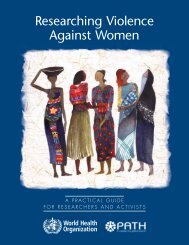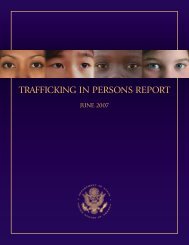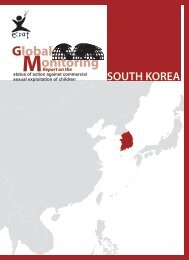Download PDF - Violence Against Children - East Asia and the ...
Download PDF - Violence Against Children - East Asia and the ...
Download PDF - Violence Against Children - East Asia and the ...
You also want an ePaper? Increase the reach of your titles
YUMPU automatically turns print PDFs into web optimized ePapers that Google loves.
Cambodia<br />
or a medical emergency.<br />
However, this does not fully explain why<br />
children may continue <strong>the</strong>ir labour even after<br />
such crises pass. During our initial research<br />
among children who work as itinerant scrap<br />
collectors in Phnom Penh, it was found that<br />
<strong>the</strong> children often have o<strong>the</strong>r motivations for<br />
working:<br />
Child scrap collectors at work on a garbage dump truck<br />
Photo: World Vision Cambodia<br />
undertaken that reveal some key principles<br />
that apply when working with children in<br />
poor urban communities. Targeted<br />
approaches, that increase <strong>the</strong> options<br />
available to children <strong>and</strong> <strong>the</strong>ir families, reduce<br />
<strong>the</strong> risks of exploitation <strong>and</strong> involvement in<br />
hazardous labour.<br />
The principles for program planning in <strong>the</strong><br />
following section are taken from World<br />
Vision Cambodia’s publication Look Before You<br />
Leap: Strategic approaches to urban child<br />
labour. 2<br />
Working principles/<br />
philosophy: An integrated<br />
approach that builds child<br />
participation<br />
Underst<strong>and</strong>ing <strong>and</strong> respecting <strong>the</strong><br />
child labourer’s perspective<br />
It is widely accepted that poverty is a primary<br />
factor that contributes to <strong>the</strong> entry of<br />
children into hazardous or exploitive labour.<br />
While o<strong>the</strong>r factors exist, most children<br />
working at <strong>the</strong> Phnom Penh city garbage<br />
dump or on <strong>the</strong> streets began when <strong>the</strong>re<br />
was a crisis impacting family income or<br />
expenses, such as a parent’s business failing<br />
“Child scrap collectors differ from many o<strong>the</strong>r<br />
child labourers in that <strong>the</strong>y are self-employed<br />
<strong>and</strong> usually possess a great deal of autonomy in<br />
<strong>the</strong>ir work. For instance, ra<strong>the</strong>r than giving all<br />
of <strong>the</strong> money to <strong>the</strong>ir parents at <strong>the</strong> end of <strong>the</strong><br />
day, many children told us that <strong>the</strong>y kept some<br />
for <strong>the</strong>mselves to buy snacks, play snooker <strong>and</strong><br />
video games, <strong>and</strong> even gamble. In this sense<br />
<strong>the</strong>y are not unlike children in developed<br />
countries who want spending money of <strong>the</strong>ir<br />
own. This was also indicated during group<br />
discussions in which a significant number said<br />
<strong>the</strong>y would continue to work at <strong>the</strong> dump at<br />
least part-time, even if <strong>the</strong>ir parents earned<br />
enough money to send <strong>the</strong>m to school <strong>and</strong><br />
provide a decent living st<strong>and</strong>ard.” 3<br />
While perhaps not present in <strong>the</strong> beginning,<br />
over time <strong>the</strong> children may develop positive<br />
attitudes such as <strong>the</strong>se towards <strong>the</strong>ir work<br />
that may contribute to <strong>the</strong>ir long-term<br />
involvement. There are, in fact, many reasons<br />
which make scrap collecting an attractive<br />
occupation for children (as well as adults): it<br />
offers flexible hours <strong>and</strong> year-round<br />
availability, is close to home (particularly for<br />
those living near <strong>the</strong> dump), <strong>and</strong> is accessible<br />
to people of a wide range of ages <strong>and</strong><br />
educational levels. These are just a few of <strong>the</strong><br />
advantages that <strong>the</strong> community sees yet <strong>the</strong><br />
outsider rarely notices, <strong>and</strong> that are crucial to<br />
underst<strong>and</strong> in order to offer alternatives<br />
which are accepted <strong>and</strong> supported by <strong>the</strong><br />
children <strong>and</strong> <strong>the</strong>ir parents. It has been noted<br />
in ILO studies on child labour that <strong>the</strong> unit of<br />
analysis is usually an adult concern such as <strong>the</strong><br />
family or <strong>the</strong> school. But “childhood is an<br />
interesting phenomenon in its own right.<br />
Child-centred studies/statistics are different<br />
2<br />
3<br />
Gourley, S, Un, V & Gray, L, Look Before You Leap: Strategic approaches to urban child labour, World Vision Cambodia, 1999. This book, which has not<br />
been widely circulated outside Cambodia, contains valuable insights into working with <strong>the</strong> urban poor to tackle <strong>the</strong> issue of child labour, to which this<br />
present chapter is indebted.<br />
Child Scrap Collectors in Phnom Penh: A profile, World Vision Cambodia, 1997<br />
24

















